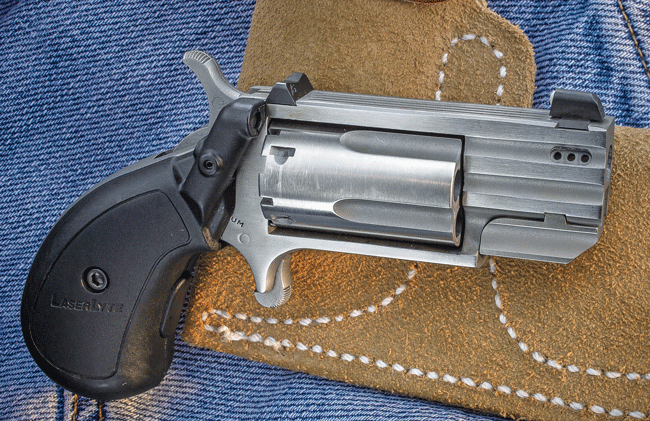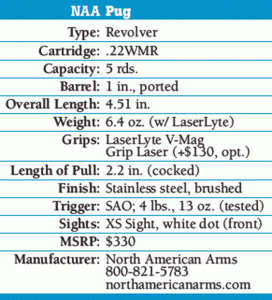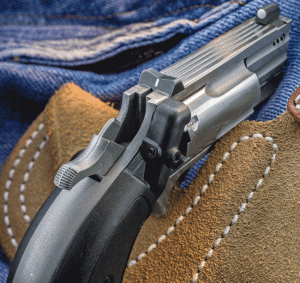November 29, 2017
By Eric R. Poole
 It can fit in your palm. Like the short-muzzled face of the wrinkly breed of dog, Pug is an appropriate name for NAA's little ankle biter. In fact, wearing one as an ankle gun is a pretty good role for this five-shot revolving backup. It chambers the potent .22 Magnum for which even a few companies have developed self-defense loads. As for G&A's staff, we'd only regard .22 Magnum as a backup to your secondary pistol for defense.
It can fit in your palm. Like the short-muzzled face of the wrinkly breed of dog, Pug is an appropriate name for NAA's little ankle biter. In fact, wearing one as an ankle gun is a pretty good role for this five-shot revolving backup. It chambers the potent .22 Magnum for which even a few companies have developed self-defense loads. As for G&A's staff, we'd only regard .22 Magnum as a backup to your secondary pistol for defense.
 The Pug weighs just 6.4 ounces unloaded, has a 1-inch barrel and an overall length of 41/2 inches. If it could stand on four legs, it'd be less than 3 inches tall and less than 1-inch wide. It isn't hard for the Pug to go unnoticed and disappear in any hideout.
The Pug weighs just 6.4 ounces unloaded, has a 1-inch barrel and an overall length of 41/2 inches. If it could stand on four legs, it'd be less than 3 inches tall and less than 1-inch wide. It isn't hard for the Pug to go unnoticed and disappear in any hideout.
What impresses me most about the Pug is the lockwork. The ratcheting of the cylinder as you cock the hammer and the crispness of its single action makes me believe that an out-of-work Swiss master watchmaker found employment at NAA.
Admitedly, I acquired an NAA Pug long before writing this, and I've shot several hundred rounds through it. So, you could consider this review a sort of long-term evaluation.
Advertisement
Let's first talk safety. There isn't a transfer bar in the Pug, as with many compact revolvers. The firing pin is actually a blade that could rest over the cartridge rim, which means that an unknown amount of force could cause an unintentional discharge. Therefore, NAA cleverly engineered a safety notch between the chambers. The hammer needs to be lowered into one of these notches after the gun is loaded if you intend to carry it. Then, when you're ready to shoot, pull back the hammer and the cylinder rotates to the next chamber. NAA rightly suggests that we practice using the notch with an unloaded cylinder.
 The grip on the Pug is a nod to the legendary Colt bird's-head grip. This grip profile was originally designed for Colt Derringers in the 1850s; it was later incorporated into full-frame revolvers in 1877 and carried on by many subsequent clones. It's a comfortable grip that conceals well, but the size of the grip is enough to hold with just two fingers. This means that we can't shoot in a panic, which is arguably a good thing since we also have to slow down and deliberately try to align the Pug's XS Sights for any hopes at accuracy. The Pug can be had with a tritium night sight version of XS Sights' Big Dot, but I prefer a laser with this type of revolver.
The grip on the Pug is a nod to the legendary Colt bird's-head grip. This grip profile was originally designed for Colt Derringers in the 1850s; it was later incorporated into full-frame revolvers in 1877 and carried on by many subsequent clones. It's a comfortable grip that conceals well, but the size of the grip is enough to hold with just two fingers. This means that we can't shoot in a panic, which is arguably a good thing since we also have to slow down and deliberately try to align the Pug's XS Sights for any hopes at accuracy. The Pug can be had with a tritium night sight version of XS Sights' Big Dot, but I prefer a laser with this type of revolver.
Though it would appear to be appropriate for such a tiny revolver, I wish this pistol had more precise sights for aiming. The XS Big Dot obscures too much of the target area and lets us forget that it has to sit on top of the rear sight's V-notch and post. When I yank one, it's usually going to hit high. (It happens a lot.) Thankfully, this revolver can be fitted with a set of LaserLyte V-Mag Grip Lasers, which improved our predictable accuracy and improved speed. (I wish that LaserLyte had given its laser grip some texturing for control.) The red laser benefited performance except in the brightest of lighting conditions, where it washed out.
Advertisement
Magnum-frame NAA revolvers such as the Pug can be ordered with an additional .22LR cylinder. They are not interchangeable with other NAA revolvers and must be timed for your revolver at the factory. That said, we tested for velocity and accuracy between .22LR and .22WMR loads. For some reason, we achieved better accuracy at 15 and 25 yards using the affordable .22LR than .22WMR loads.
Even for its nuances, people, including myself, like the Pug — though its bark is probably scarier than its bite.
Enjoy articles like this?
Subscribe to the magazine.
Get access to everything Guns & Ammo has to offer.
Subscribe to the Magazine

